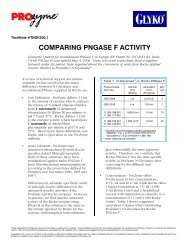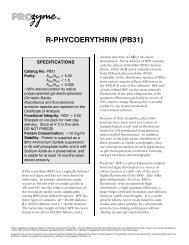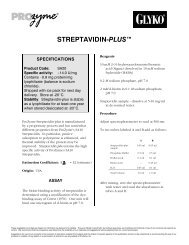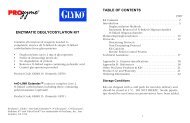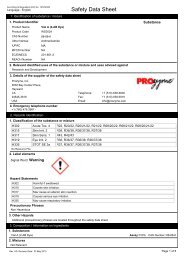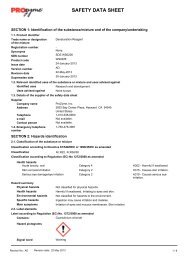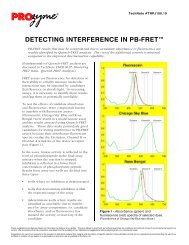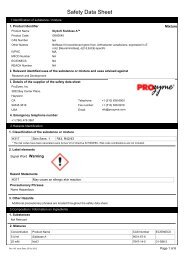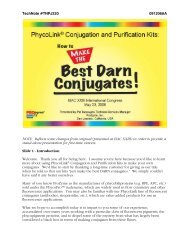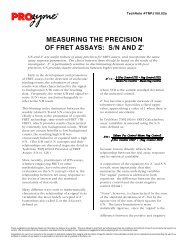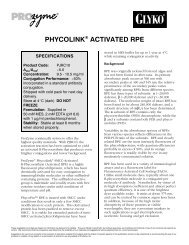Safety Data Sheet - ProZyme
Safety Data Sheet - ProZyme
Safety Data Sheet - ProZyme
Create successful ePaper yourself
Turn your PDF publications into a flip-book with our unique Google optimized e-Paper software.
<strong>Safety</strong> <strong>Data</strong> <strong>Sheet</strong><br />
1:Identification of substance / mixture<br />
1. Product Identifier<br />
Product Name<br />
5x 2-AB Sample Load Solution<br />
Product Code<br />
WS0303<br />
CAS Number<br />
NA<br />
Other Names<br />
IUPAC<br />
NA<br />
MFCD Number<br />
NA<br />
EC/EINECS<br />
NA<br />
REACH Number<br />
NA<br />
2. Relevant identified uses of the substance or mixture and uses advised against<br />
Research and Development<br />
Mixture<br />
3. Details of the supplier of the safety data sheet<br />
<strong>ProZyme</strong>, Inc<br />
3832 Bay Center Place,<br />
Hayward<br />
CA<br />
Telephone:<br />
94545-3619<br />
Fax number:<br />
USA<br />
Email:<br />
4. Emergency telephone number<br />
+1 (760) 476 3961<br />
+1 (510) 638-6900<br />
+1 (510) 638 6919<br />
info@prozyme.com<br />
2.Hazards Identification<br />
1. Classification of the substance or mixture<br />
H226 Flam Liq. 3 R10<br />
H335 STOT SE 3a R37, R36/37, R36/37/38, R37/38<br />
* The risk codes have been generated using Annex VII of directive 67/548/EEC. Risk code combinations are not included.<br />
2. Label elements<br />
Signal Word Warning<br />
Hazard Statements<br />
H226<br />
H335<br />
Precautionary Phrases<br />
P210<br />
3. Other Hazards<br />
Additional precautionary phrases are located throughout the safety data sheet<br />
3.Composition / Information on Ingredients<br />
1. Substances<br />
Not Relevant<br />
Flammable liquid and vapour.<br />
May cause respiratory irritation.<br />
Keep away from heat/sparks/open flames/hot surfaces. – No smoking.<br />
2. Mixtures: There are no additional ingredients present which, within the current knowledge of the supplier and in the<br />
concentrations applicable,are classified as hazardous to health or the environment and hence require reporting in this<br />
section.<br />
Rev AB Revision Date: 28 May 2013<br />
Page 1 of 7
<strong>Safety</strong> <strong>Data</strong> <strong>Sheet</strong><br />
Concentration Product Name CAS Number EC/EINECS<br />
60-90% Dimethyl Sulfoxide 67-68-5 200-664-3<br />
< 2% Trifluoroacetic Acid 73-05-1 200-929-3<br />
4.First Aid Measures<br />
1.Description of first aid measures<br />
Skin Contact Wash immediately with plenty of soap and water. If symptoms arise, consult a physician.<br />
Eye Contact<br />
Ingestion<br />
Inhalation<br />
Rinse with plenty of water for 15 minutes. If symptoms arise, consult a physician.<br />
Wash out mouth with water. Never give anything by mouth to an unconscious person. If symptoms arise,<br />
consult a physician. Do not induce vomiting without medical advice.<br />
P304 + P340: IF INHALED: Remove victim to fresh air and keep at rest in a position comfortable for breathing.<br />
If symptoms arise, call a physician. If not breathing, give artificial respiration.<br />
2.Most important symptoms and effects<br />
May be harmful if swallowed, inhaled or absorbed through the skin. May cause irritation to skin, eyes and respiratory tract.<br />
3.Indication of any immediate medical attention<br />
Obtain medical attention in the event of any acute or delayed symptoms.<br />
5.Firefighting measures<br />
1.Extinguishing Media<br />
Suitable<br />
Unsuitable<br />
For small (incipient) fires, use media such as "alcohol" foam, dry chemical, or carbon dioxide. For large fires,<br />
apply water from as far as possible.<br />
NA<br />
2.Special Hazards arising from the substance or mixture<br />
Combustible. Moderate fire hazard when exposed to heat or flame (fire data for dimethyl sulfoxide).<br />
3.Advice for Fire Fighters<br />
Wear self-contained breathing apparatus and protective clothing for firefighting. Use water spray to cool unopened containers.<br />
6.Accidental Release Measures<br />
1.Personnal Precautions<br />
Avoid breathing vapors, mist or gas. Refer to section 8 of SDS for personal protection details.<br />
2.Environmental Precautions<br />
Prevent further leakage or spillage if safe to do so. Do not let product enter drains or rivers.<br />
3.Methods & Materials<br />
Remove all sources of ignition. Beware of vapours accumulating to form explosive concentrations. Vapours can accumulate in low<br />
areas. Contain spillage and neutralize with alkaline material (soda ash, lime), then absorb with an inert material (e.g. vermiculite,<br />
dry sand, earth), and place in a chemical waste container for disposal according to local regulations. Do not use combustible<br />
materials. Do not flush to sewer.<br />
Page 2 of 7
<strong>Safety</strong> <strong>Data</strong> <strong>Sheet</strong><br />
7.Handling and Storage<br />
1.Personnal Precautions<br />
Safe Handling<br />
Protection against<br />
explosions and fires<br />
Use personal protective equipment. Avoid inhalation of vapour or mist.<br />
Keep away from sources of heat or ignition.<br />
2.Conditions for safe storage, including any incompatibilities<br />
Managing Storage Risks<br />
Storage Controls<br />
Maintaining Integrity<br />
Other advice<br />
Keep container tightly closed in a dry and well-ventilated place. Protect from physical damage.<br />
Store according to product labeling.<br />
P210: Keep away from heat/sparks/open flames/hot surfaces. – No smoking.<br />
P233: Keep container tightly closed.<br />
Store at room temperature.<br />
Handle and store in accordance with all current regulations and standards.<br />
3.Specific End Uses<br />
The end use(s) have not been fully determined. The substance is supplied for Research and Development purposes by<br />
professionals only.<br />
8.Exposure Controls/Personal Protection<br />
1. Control Parameters<br />
Not Applicable<br />
2.Exposure Controls<br />
General protective and<br />
hydgiene measures<br />
Engineering measures<br />
Eye / Face Protection<br />
Hand protection<br />
Respiratory protection<br />
Skin protection<br />
Other personal protection<br />
advice<br />
P280: Wear protective gloves/protective clothing/eye protection/face protection.<br />
Ensure there is sufficient ventilation of the area.<br />
<strong>Safety</strong> Glasses with side-shields.<br />
Protective gloves such as nitrile.<br />
P261: Avoid breathing dust/fume/gas/mist/vapours/spray.<br />
Where risk assessment shows air-purifying respirators are appropriate use a full-face respirator with<br />
multi-purpose combination (US) or type ABEK (EN 14387) respirator cartridges as a backup to<br />
engineering controls. If the respirator is the sole means of protection, use a full-face supplied air<br />
respirator. Use respirators and components tested and approved under appropriate government<br />
standards such as NIOSH (US) or CEN (EU).<br />
Wear appropriate protective clothing (safety glasses, gloves, laboratory coat).<br />
NA<br />
9.Physical and Chemical Properties<br />
1. Physical and Chemical Properties<br />
Appearance<br />
Odour<br />
Odour threshold<br />
PH<br />
Melting point / Freezing point<br />
Initial boiling point and boiling range<br />
Flash point<br />
Evaporation rate<br />
Clear, colorless<br />
Pungent odor<br />
Not Applicable<br />
Not Applicable<br />
Not Applicable<br />
Not Applicable<br />
Not Applicable<br />
Not Applicable<br />
Page 3 of 7
<strong>Safety</strong> <strong>Data</strong> <strong>Sheet</strong><br />
Flammability(solid,gas)<br />
Upper/lower flammability or explosive limits<br />
Vapour pressure<br />
Vapour density<br />
Relative density<br />
Solubility(ies):<br />
Partition coefficient: n-octanol/water<br />
Auto-ignition temperature<br />
Decomposition temperature<br />
Viscosity<br />
Explosive properties<br />
Oxidising properties<br />
Not Applicable<br />
Not Applicable<br />
Not Applicable<br />
Not Applicable<br />
Not Applicable<br />
Miscible in water<br />
Not Applicable<br />
Not Applicable<br />
Not Applicable<br />
Not Applicable<br />
Not Applicable<br />
Not Applicable<br />
2.Other Information<br />
NA<br />
10.Stability and Reactivity<br />
1.Reactivity<br />
No dangerous reaction known under conditions of normal use.<br />
2.Stability<br />
Stable under recommended storage conditions.<br />
3.Possibility of Hazardous Reactions<br />
No hazardous reactions known.<br />
4.Conditions to Avoid<br />
Sources of ignition, heat, flames and incompatibles.<br />
5.Incompatible Materials<br />
Acylhalides, arylhalides, bromobenzoyl acetanilide, magnesium perchlorate, perchloric acid, strong bases, strong oxidizing agents<br />
and strong reducing agents.<br />
6.Hazardous Decomposition Products<br />
Hazardous decomposition products formed under fire conditions: Carbon oxides, sulphur oxides, formaldehyde, methyl mercaptan<br />
and hydrogen fluoride.<br />
Other decomposition products - no data available<br />
11.Toxicology information<br />
1.Information<br />
Acute Toxicity<br />
Skin corrosion/irritation<br />
DMSO: Oral LD50 - rat - 14,500 mg/kg<br />
Trifluoroacetic Acid: Oral LD50 - rat - 200-400 mg/kg<br />
May be harmful if absorbed through the skin. May cause skin irritation.<br />
Serious eye<br />
Damage/irratation<br />
Respiratory or skin<br />
sensitisation<br />
Germ Cell mutagenicity<br />
Carcinogenicity<br />
Reproductive toxicity<br />
STOT-single exposure<br />
May cause eye irritation.<br />
May be harmful if inhaled.<br />
No data available.<br />
No data available.<br />
DMSO: No data available.<br />
TFA: Undiluted TFA has shown reproductive toxicity effects on laboratory animals.<br />
No data available.<br />
Page 4 of 7
<strong>Safety</strong> <strong>Data</strong> <strong>Sheet</strong><br />
STOT-repeated exposure<br />
Aspiration hazard<br />
2.Additional<br />
No data available.<br />
May be harmful if inhaled.<br />
To the best of our knowledge, the toxicological, carcinogenic and mutagenic properties have not been thoroughly investigated.<br />
DMSO: Avoid contact with solutions containing toxic or potentially toxic materials. DMSO is readily absorbed through the skin and<br />
may carry such materials into the body.<br />
12.Ecological Information<br />
1.Toxicity<br />
No data available.<br />
2.Persistance and degradability<br />
Difficult to biodegrade.<br />
3.Bio-Accumulative Potential<br />
This material is not expected to significantly bioaccumulate.<br />
4.Mobility and Soil<br />
No data available.<br />
5.Results of PBT & vPvB assessment<br />
No data available.<br />
6.Other adverse effects<br />
No data available.<br />
13.Disposal Considerations<br />
1.Waste Treatment Methods<br />
Disposal Operations<br />
Disposal of Packaging<br />
Whatever cannot be saved for recovery or recycling should be managed in an appropriate and<br />
approved hazardous waste disposal facility. Dispose of container and unused contents in accordance<br />
with federal, state and local requirements.<br />
Dispose of as unused product.<br />
14. Transport Information<br />
Air (ICAO)<br />
Not classified as hazardous for transport<br />
Road (ADR)<br />
Not classified as hazardous for transport<br />
Sea (IMDG)<br />
Not classified as hazardous for transport<br />
Page 5 of 7
15.<strong>Safety</strong>, health and environmental regulations<br />
1.<strong>Safety</strong>, health and environmental regulations:<br />
OSHA Hazards<br />
Combustible Liquid<br />
TSCA Listing<br />
Dimethylsulfoxide (67-68-5) Yes<br />
Trifluoroacetic Acid (76-05-1) Yes<br />
SARA 302 Components<br />
SARA 302: No chemicals in this material are subject to the reporting requirements of SARA Title III, Section 302.<br />
SARA 313 Components<br />
SARA 313: This material does not contain any chemical components with known CAS numbers that exceed the threshold (De<br />
Minimis) reporting levels established by SARA Title III, Section 313.<br />
SARA 311/312 Hazards<br />
Fire Hazard, Chronic Health Hazardldrich - W387509 Page 7 of 7<br />
Massachusetts Right To Know Components<br />
No components are subject to the Massachusetts Right to Know Act.<br />
Pennsylvania Right To Know Components<br />
Dimethyl sulfoxide (67-68-5) Revision Date: 2007-03-01<br />
New Jersey Right To Know Components<br />
Dimethyl sulfoxide (67-68-5) Revision Date: 2007-03-01<br />
California Prop. 65 Components<br />
This product does not contain any chemicals known to State of California to cause cancer, birth defects, or any other<br />
reproductive harm.<br />
2. <strong>Safety</strong> Assessment<br />
No Chemical <strong>Safety</strong> Assessment<br />
16.Other Information<br />
1.Other Information:<br />
ADR: Accord Europeen sur le transport des merchandises Dangereuses par Route(European Agreement concerning the<br />
International Carriage of Dangerous Goods by road)<br />
RID:Reglement International concernant le transport des merchandises dangereuses par chemin de fer (Regulations concerning the<br />
International transport of Dangerous Goods by Rail)<br />
IMDG: International Maritime Code for Dangerous Goods<br />
IATA: International Air Transport Association<br />
IATA-DGR: Dangerous Goods Regulations by the International Air Transport Association<br />
ICAO:International Civil Aviation Organization<br />
ICAO-TI: Technical Instructions by the ICAO<br />
GHS: Globally Harmonized System of Classification and Labelling of Chemicals<br />
CAS:Chemical Abstracts Service<br />
R10<br />
Flammable.<br />
R36/37 Irritating to eyes and respiratory system.<br />
R36/37/38<br />
R37<br />
Irritating to eyes, respiratory system and skin.<br />
Irritating to respiratory system.<br />
R37/38 Irritating to respiratory system and skin.<br />
<strong>Safety</strong> <strong>Data</strong> <strong>Sheet</strong><br />
2. Associated risk phrases according to european directive 67/548/EEC<br />
3. Disclaimer<br />
Page 6 of 7
<strong>Safety</strong> <strong>Data</strong> <strong>Sheet</strong><br />
The product listed is for research and development purposes only and not for human or animal use. As such, in most cases, the<br />
toxicological, ecological and physicochemical properties have not been fully determined and the product should be treated with<br />
respect and always handled under suitable conditions by appropriately qualified personnel. The responsible party shall use this<br />
datasheet only in conjunction with other sources of information gathered by them, and should make an independent judgement of<br />
suitability, to ensure proper use and protect the health and safety of employees. This information is furnished without warranty and<br />
any use of the product not in conformance with this material safety data sheet, or in combination with any other product or process,<br />
is the responsibility of the user.<br />
The above information is supplied in good faith and is believed to be correct. It does not claim to be all-inclusive and is intended to<br />
be used only as a guide. Final determination of the suitability of any material is the sole responsibility of the user. <strong>ProZyme</strong> shall<br />
not be held responsible for any damage resulting from handling or contact with the above product. This product is intended for in<br />
vitro research only.<br />
Page 7 of 7



